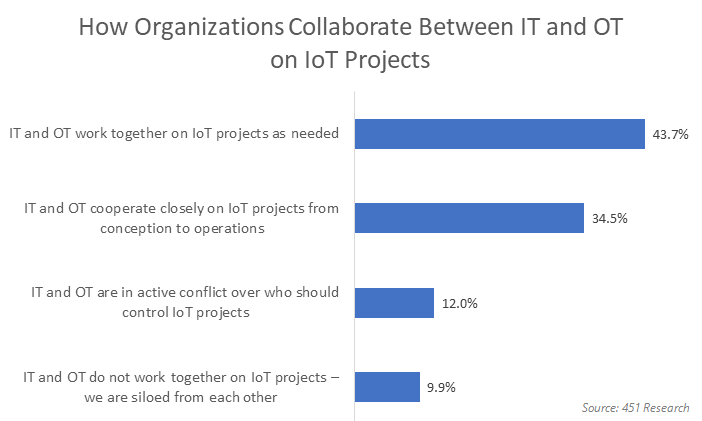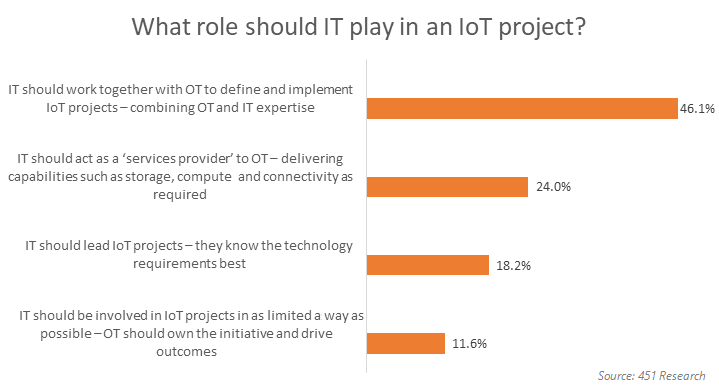
The potential for Internet of Things (IoT) technology to create smart, connected networks within a wide range of environments has far-reaching implications for businesses. IoT may complicate organizational structures and intertwine stakeholders traditionally left separate.
This has been a challenge for companies deploying industrial IoT (IIoT) projects. In these cases, two distinct constituencies now find themselves on the same playing field: IT and OT.
Smart IIoT demands collaboration between traditional information technology (IT) teams and operational technology (OT) players who manage operations-centric systems. As IIoT initiatives balloon in scale and scope, the lines that once separated them are blurring. Collaboration encompasses IoT decision-making, project management and execution.
According to a survey of OT practitioners conducted by 451 Research, adoption of IoT is quickly growing. 37% of respondents claim to have deployed projects in use, while 21% have projects in the proof of concept stage. An additional 24% plan to implement projects within the next two years.
This poses both immediate and ongoing implications on the organizational dynamics surrounding the planning, execution and management of IoT initiatives in industrial environments, ultimately making or breaking their success.
What is Operational Technology (OT)?
In a handful of industries, the technology that runs the core part of the business is not traditional IT (e.g., servers, cloud or datacenters).
Instead, a collection of hardware and software systems controls and monitors physical processes. This is referred to as operational technology. Industries dominated by OT include manufacturing, utilities and mining.
How do IT and OT differ?
Fundamentally, OT is anchored in machine performance and the uptime of physical and embedded technological processes, whereas IT is more heavily focused on the spectrum of information technologies from software and hardware to related services. These differences directly influence the organization of IoT projects in the following ways.
Team Structure
Within industrial organizations, IT and OT functions and decision-making are typically led by different groups.
IT is led by corporate IT teams or departments, headed by CIOs and other C-suite executives. OT practices are typically led by production floor or other operationally focused managers, often involving systems engineers and operations executives as well as an entirely different set of external vendors and other non-IT stakeholders. Roles and functions between the respective groups differ, leading to further disconnect in terms of the organization, delegation and management of projects.
Differing Skill Sets
OT involves highly specialized systems running critical infrastructure, like water pipelines and electrical plants. That means there are often significant gaps in knowledge of OT-specific systems and environments within the IT realm.
Drivers and Inhibitors
Although there is some overlap in sentiments between the two constituencies, namely the overarching goal to optimize operations with IoT initiatives, their methods to achieve this vary widely even within the same industry vertical.
This complexity threatens organizational culture, risks interoperability and introduces security challenges that must be overcome in the name of successful collaboration.
Budgets and ROI
Because OT practitioners are more directly tied to production and output, they are more budget-driven than traditional IT groups.
OT is less about ‘projects for digital transformation’s sake’ and more often requires that IoT projects have measurable KPIs and metrics to deliver a measurable return on investment (ROI).
The number one impediment to IoT project success as cited by OT respondents in a recent 451 survey remains technology deployment and integration challenges, ultimately stemming from greater complexity and skills/knowledge gaps. IT and OT each harbor critical competencies pivotal to the success of IIoT initiatives. They must bridge the gap between their incongruencies to succeed.
The Convergence of IT and OT
Despite the IT/OT schism, collaboration between the two sides is critical to IoT success. Nearly 44% of OT respondents in a recent 451 Research survey report that IT and OT currently work together on IoT projects on an as-needed basis, with 35% claiming they cooperate closely from conception to operation.

Increasingly, organizations are embracing a convergence of IT and OT as driven by IIoT requirements, with nearly half of OT practitioners believing IT and OT should combine expertise and work together on projects.
Our data suggests that close collaboration between IT and OT is clearly linked to progress in digital transformation.

Instead of distributing functions on an IoT project-to-project basis, a more holistic combination of both roles and expertise achieves optimal results.
Over the next two years, 41% of OT practitioners anticipate that these roles will increasingly overlap. An additional 40% predict that an entirely new hybrid role will emerge as a result of IoT requirements, marking a significant organizational and strategic mindset shift within IIoT environments.
Outlook for Future IT and OT Job Functions

Implications for Organizational Dynamics
IoT drives digital transformation within organizations and its success hinges upon the ability of two separate worlds, IT and OT, with separate systems, technologies and stakeholders, to successfully collaborate. Strong leadership from the executive suite is key to understand these role shifts and dedicate the necessary resources to support IT and OT convergence within the organization and spread crucial awareness and education.
Want insights on IoT trends delivered to your inbox? Join the 451 Alliance.


One Reply to “Bridging the Gap Between Operational Technology and IT”
Comments are closed.